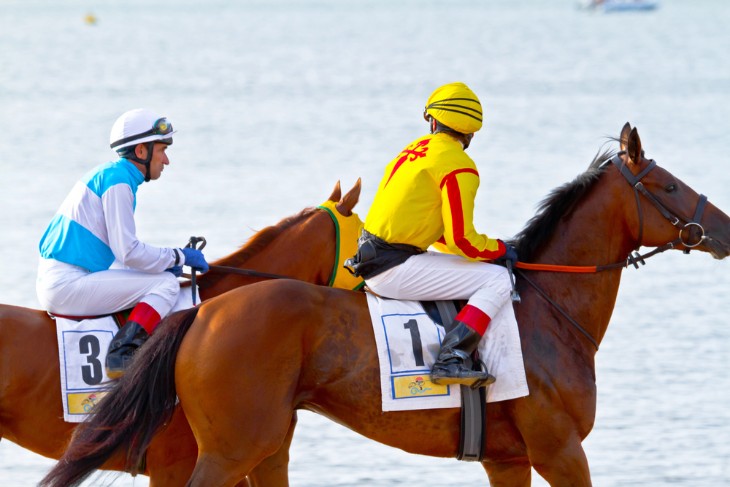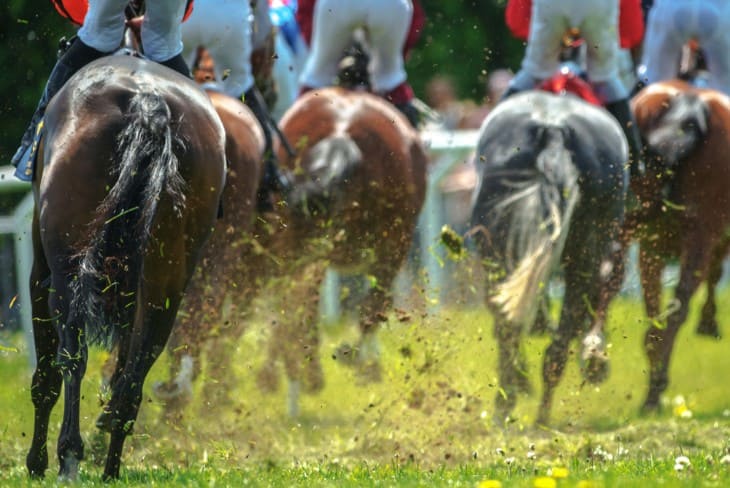- The Origins of "Nap" in Horse Racing Vocabulary
- Nap: Definition and Usage in Betting Circles
- How Tipsters Influence the Nap Selection
- Comparing "Nap" with Other Horse Racing Jargon
- The Impact of Social Media on Nap Selections and Betting Trends
- Statistical Analysis in Determining a Nap
- Naps and Punter Confidence
- International Perspectives on Nap Selection in Horse Racing
- Conclusion
The Origins of "Nap" in Horse Racing Vocabulary
The term "nap" origins are often attributed to the card game Napoleon, where the best hand a player can declare is a "Napoleon," shortened to "nap". This association with a winning hand seamlessly transitioned into horse racing, where a "nap" denotes a tipster's best bet of the day. The term gained prominence in the 19th century, becoming a staple in racing vernacular. It not only reflects the confidence of a tipster in a particular horse but also serves as a guide for bettors navigating the complexities of horse racing bets.
Nap: Definition and Usage in Betting Circles
The term "nap" in horse racing betting is not just a piece of jargon; it is a cornerstone of the betting lexicon. Defined as the strongest bet or the 'best bet of the day' by a tipster, it represents a high level of confidence in the horse's chances of winning. The selection of a nap is a crucial aspect of a tipster's daily recommendations and is often eagerly anticipated by bettors. The process of choosing a nap involves meticulous analysis and deep understanding of horse racing dynamics. It's not a random pick, but a carefully considered decision based on various factors:
- Horse's Form: Examining the recent performance of the horse, including wins and places.
- Track Conditions: Considering how the horse performs in different weather and track conditions.
- Competition: Assessing the strength of the other horses in the race.
The use of "nap" as a term has evolved over the years. Initially exclusive to expert tipsters in newspapers and racing forms, it has now permeated into online betting communities and social media platforms. The term's popularity underscores the importance of expert advice in the horse racing betting world, where the insights of seasoned tipsters can be invaluable.
How Tipsters Influence the Nap Selection
Tipsters play a pivotal role in the world of horse racing betting, particularly in the selection of a nap. Their expertise and insight are often the guiding forces behind many bettors' decisions. A tipster's reputation is built on their ability to consistently identify winning horses, making their nap selections highly influential. They analyse various factors including horse performance, training updates, jockey skills, and track conditions to make their pick.
The influence of a tipster's nap extends beyond individual bettors to the betting market itself. A highly respected tipster's endorsement of a horse as a nap can lead to a significant shift in betting odds, reflecting the weight their opinion holds in the community. This phenomenon highlights the interconnected nature of tipster recommendations, bettor decisions, and betting markets.
The reliance on tipsters for nap selections also underlines a broader aspect of horse racing betting – the blend of skill, knowledge, and intuition. While data and statistics form the backbone of horse racing analysis, the intuition and experience of a seasoned tipster often make the difference. Their ability to read between the lines, to understand the nuances of horse racing, transforms a statistical guess into an educated, insightful bet.

Comparing "Nap" with Other Horse Racing Jargon
While "nap" is a term that holds significant weight in the betting world, it is one of many used in horse racing. Comparing it with other jargon illuminates the breadth and depth of the language used in this sport. Each term offers insight into different aspects of betting and racing, and understanding these terms can greatly enhance one's appreciation and success in horse racing betting.
- Banker: Similar to a nap, a banker is a bet deemed highly likely to win. However, it is often used in the context of accumulator bets.
- Drifter: A horse whose odds are getting longer due to lack of support or negative news.
- Steamer: The opposite of a drifter, a steamer is a horse whose odds are shortening, often due to heavy betting support.
- Maiden: Refers to a horse that has never won a race.
Each of these terms, like "nap," serves a specific purpose and conveys particular information crucial to understanding the dynamics of horse racing and betting. The language of horse racing is rich and varied, reflecting the complexity and the historical depth of the sport. Understanding these terms is not only about gaining an edge in betting but also about connecting with the heritage and culture of horse racing.
The Impact of Social Media on Nap Selections and Betting Trends
Social media has revolutionized many aspects of daily life, and the world of horse racing betting is no exception. Its impact on nap selections and betting trends is significant and multifaceted. Platforms like Twitter, Facebook, and various horse racing forums have become vital spaces for the exchange of information and opinions regarding nap selections. Social media allows tipsters to share their insights with a broader audience, while bettors can access a wealth of information with unprecedented ease and speed.
This accessibility to information has its pros and cons. On the one hand, it democratizes the betting process, allowing amateur bettors to make more informed decisions. On the other hand, the sheer volume of information and the variety of opinions can be overwhelming and sometimes misleading. Furthermore, the rapid spread of information via social media can lead to sudden and significant shifts in betting odds, as a large number of bettors react to a tipster's nap selection. This dynamic environment requires bettors to be discerning in their sources and agile in their decision-making.
Statistical Analysis in Determining a Nap
Statistical analysis plays a critical role in determining a nap in horse racing. The selection process is not just based on hunches or simple observations; it involves a detailed examination of a range of data points to gauge a horse's winning potential. Key statistics considered by tipsters and bettors include:
- Win/Place Percentage: This measures the frequency of a horse finishing in winning or placing positions.
- Average Speed Rating: An indicator of a horse's average performance across races, considering the speed of the track.
- Jockey/Trainer Statistics: The track record of the jockey and trainer, as their skill and strategy significantly impact a horse's performance.
These statistics are often compiled and analysed using sophisticated software, allowing for a more nuanced understanding of a horse's capabilities. Additionally, historical data is used to identify patterns and trends, which can be critical in predicting future performance. For instance, how a horse has performed under similar track conditions, or how it has responded to different distances in the past, can inform the selection of a nap.
The reliance on statistical analysis underscores the evolution of horse racing betting from a game of mere chance to a more strategic endeavour. It reflects a growing sophistication in the approach to betting, where data-driven decisions are increasingly becoming the norm. This shift has not only enhanced the betting experience but has also added a layer of rigour and professionalism to the sport.

Naps and Punter Confidence
The psychology of betting plays a significant role in the world of horse racing, particularly in relation to naps. The selection of a nap by a reputable tipster often boosts the confidence of punters in their betting choices. This psychological aspect is a crucial element in the betting process, as confidence can influence betting behaviour and decision-making.
- Herd Mentality: When a horse is declared as a nap by a well-known tipster, it often leads to a bandwagon effect, where a large number of punters place bets on that horse. This collective behaviour can significantly shift the odds.
- Risk Perception: The endorsement of a horse as a nap can alter a punter's perception of risk. A nap is seen as a safer bet, leading to larger or more frequent wagers.
- Overconfidence: While the selection of a nap can provide reassurance, it can also lead to overconfidence. Punters may overestimate the certainty of the outcome, disregarding the inherent unpredictability of horse racing.
Understanding the psychological aspects of betting is as important as grasping the technical aspects. It helps in maintaining a balanced approach to betting, where decisions are made not just based on data and expert opinions, but also with an awareness of one's own betting behaviour and attitudes.
International Perspectives on Nap Selection in Horse Racing
The concept of selecting a nap in horse racing, while rooted in British betting culture, has international variations and nuances. Around the world, different horse racing communities have their own approaches and strategies for selecting a nap. These differences are influenced by various factors, including regional betting cultures, racing styles, and the availability of information.
- United States: American bettors often focus on different data sets, such as speed figures and trainer-jockey combinations, when selecting their equivalent of a nap.
- Australia: In Australian horse racing, the emphasis is often on track conditions and breeding, reflecting the country's diverse racing environments and horse pedigree.
- Hong Kong: Hong Kong's horse racing culture is known for its in-depth public handicapping information, which plays a crucial role in the nap selection process.
These international perspectives enrich the global understanding of horse racing betting. They demonstrate how the selection of a nap, although guided by universal principles like form and performance, is adapted to suit different regional contexts and preferences. This diversity not only adds depth to the sport but also offers opportunities for learning and exchange among international betting communities.
Conclusion
In conclusion, the role of the nap in horse racing and betting culture is both significant and evolving. Originally a term borrowed from card games, it has become a central part of the lexicon in horse racing betting, symbolising a tipster's confidence in a particular horse's chances. The process of selecting a nap involves a complex interplay of factors, including statistical analysis, understanding of form and performance, and insights into jockey and trainer capabilities.
For more information:







